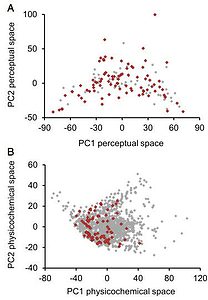You’ve heard about white color and white noise, but know there’s a new neutral signal that balances the senses, the sens of smell to be more exact – white smell! Scientists at the Weizmann Institute have shown that white odor indeed exists, although it can’t be found in nature, after they created a mixture of various pure scents to convey the perception of olfactory neutrality.
White light is produced when an assortment of different wave frequencies meet, similarly for white noise as well as the distinct hum is produced by a combination of sound frequencies. For these to occur two fundamental conditions needs to be met: all the frequencies need to be of the exact same intensity and need to travel within a perceptual space – the visible spectrum for white light and the audible range for white noise.

This latter condition is very difficult to asses for our other senses, like smell. Could a white smell exist? This is a question that has been puzzling scientists for a while and, until very recently, remained unanswered. Until, that is, a research team from the Neurobiology Department, led by research student Tali Weiss and Dr. Kobi Snitz, and supervised by Prof. Noam Sobel, took the challenge and successfully produced a white smell.
The scientists made their peculiar odor by mixing up to thirty different odors, from 86 different pure scents that represent a wide range of the kinds of things that we can smell (smell map), which were diluted in order to get the same intensity out of every odor. The human nose can distinguish thousands of sent molecules from flowery to putrid, however its dimensional spectrum is far from being mapped out neatly, as such a rather complicate maneuver was attempted.
The scientists created various blends that were presented in pairs to 150 volunteers or “professional noses”, and compared against a list of 146 different odor descriptions like “fruity” “etherish” “decayed” or “seasoning for meat”. It was found that the more different molecules were paired into mixtures, the bigger the chance that they would be rated as similar. Finally, the scientists found that blends that each contained 30 different odors or more were thought to be almost identical. It’s rather hopeless to describe white smell, because it doesn’t really smell like anything. This is incredibly confusing, and the participants in this study understandably did not know how to explain the scent.
“On the one hand,” says Sobel, “The findings expand the concept of ‘white’ beyond the familiar sight and sound. On the other, they touch on the most basic principles underlying our sense of smell, and these raise some issues with the conventional wisdom on the subject.”
White light equally activates the three color receptors of the eye – red, green and blue. Despite these new findings, the full extent of olfactory space remains unknown, but still it warrants a rephrasing of the common definition for the sense of smell. Rather than a sensor that detects individual molecules, our smell systems perceive whole scents.
The findings were reported in the journal Proceedings of the National Academy of Sciences (PNAS).
source: Weizmann Institute via Scientific American


